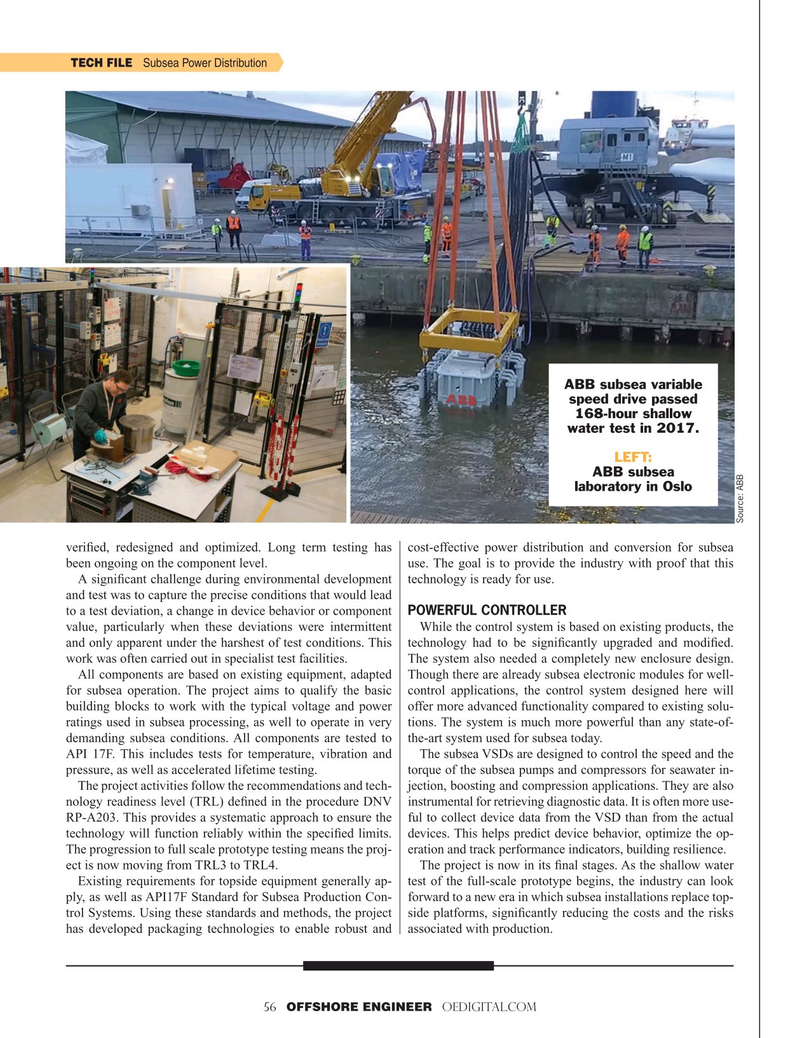
Page 56: of Offshore Engineer Magazine (May/Jun 2019)
Offshore Renewables Review
Read this page in Pdf, Flash or Html5 edition of May/Jun 2019 Offshore Engineer Magazine
TECH FILE Subsea Power Distribution
ABB subsea variable speed drive passed 168-hour shallow water test in 2017.
LEFT:
ABB subsea laboratory in Oslo
Source: ABB veri? ed, redesigned and optimized. Long term testing has cost-effective power distribution and conversion for subsea been ongoing on the component level. use. The goal is to provide the industry with proof that this
A signi? cant challenge during environmental development technology is ready for use. and test was to capture the precise conditions that would lead to a test deviation, a change in device behavior or component POWERFUL CONTROLLER value, particularly when these deviations were intermittent While the control system is based on existing products, the and only apparent under the harshest of test conditions. This technology had to be signi? cantly upgraded and modi? ed. work was often carried out in specialist test facilities. The system also needed a completely new enclosure design.
All components are based on existing equipment, adapted Though there are already subsea electronic modules for well- for subsea operation. The project aims to qualify the basic control applications, the control system designed here will building blocks to work with the typical voltage and power offer more advanced functionality compared to existing solu- ratings used in subsea processing, as well to operate in very tions. The system is much more powerful than any state-of- demanding subsea conditions. All components are tested to the-art system used for subsea today.
API 17F. This includes tests for temperature, vibration and The subsea VSDs are designed to control the speed and the pressure, as well as accelerated lifetime testing. torque of the subsea pumps and compressors for seawater in-
The project activities follow the recommendations and tech- jection, boosting and compression applications. They are also nology readiness level (TRL) de? ned in the procedure DNV instrumental for retrieving diagnostic data. It is often more use-
RP-A203. This provides a systematic approach to ensure the ful to collect device data from the VSD than from the actual technology will function reliably within the speci? ed limits. devices. This helps predict device behavior, optimize the op-
The progression to full scale prototype testing means the proj- eration and track performance indicators, building resilience. ect is now moving from TRL3 to TRL4. The project is now in its ? nal stages. As the shallow water
Existing requirements for topside equipment generally ap- test of the full-scale prototype begins, the industry can look ply, as well as API17F Standard for Subsea Production Con- forward to a new era in which subsea installations replace top- trol Systems. Using these standards and methods, the project side platforms, signi? cantly reducing the costs and the risks has developed packaging technologies to enable robust and associated with production.
56 OFFSHORE ENGINEER OEDIGITAL.COM 50-64 OE MayJune 2019.indd 56 6/10/2019 10:28:34 AM

 55
55

 57
57